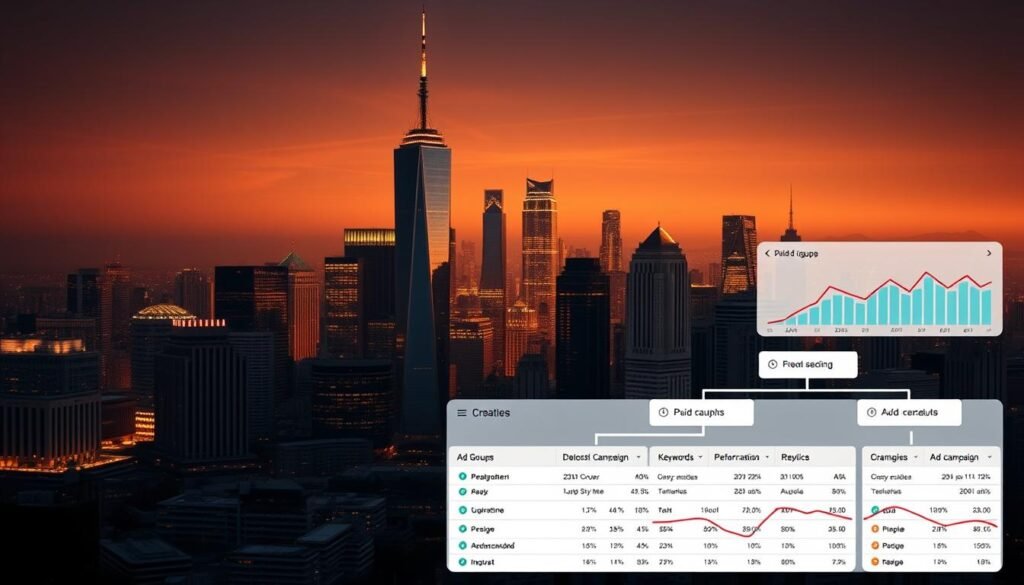In today’s competitive digital landscape, businesses are constantly seeking innovative ways to drive growth and stay ahead of the competition. Did you know that digital advertising spending is projected to reach over $517 billion by 2023? This staggering statistic highlights the importance of having a robust online advertising strategy in place.
Paid search advertising is a key component of this strategy. It allows companies to reach their target audience effectively and drive conversions. By leveraging targeted online advertising, businesses can increase their online visibility, drive website traffic, and ultimately boost sales.
Key Takeaways
- Understand the importance of paid search for business growth
- Learn how to create effective digital advertising campaigns
- Discover strategies for optimizing online advertising ROI
- Explore the benefits of targeted online advertising
- Gain insights into the latest trends in paid search advertising
The Fundamentals of Paid Search Marketing
Paid search marketing is a cornerstone in digital marketing, connecting businesses with users actively seeking their products or services. It involves bidding on keywords or phrases related to a business’s offerings. Advertisers pay each time a user clicks on their ad.
What Is Paid Search and How It Works
Paid search, or Pay-Per-Click (PPC) advertising, is a digital marketing strategy. Advertisers create ads that appear on search engines for specific keywords. The process includes keyword research, bid management, and ad creation.
Advertisers compete in ad auctions, where the highest bidder secures a top spot on the search engine results page (SERP).
The Difference Between Paid Search and Organic Search
The main distinction between paid search and organic search is how results are generated and displayed. Organic search results are based on the search engine’s algorithm, ranking content by relevance and quality without cost to the website owner. Paid search results, on the other hand, are ads displayed due to an advertiser’s payment, typically on a PPC basis.
Why Paid Search Is Essential for Business Growth
In today’s digital landscape, paid search is vital for businesses aiming to grow. With the rise in online competition, a strong paid search strategy is key. It helps businesses reach customers actively looking for what they offer.
Immediate Visibility and Traffic Generation
Paid search offers immediate visibility for businesses, placing them at the top of search engine results. This visibility leads to increased traffic, as users click on the ads to visit the business’s site. A study found that “65% of users click on a paid ad when searching online.”
“Paid search is a powerful tool for driving targeted traffic to your website.”
Measurable ROI and Performance Tracking
Paid search is known for its measurable ROI. Businesses can track their campaigns’ performance with detailed analytics. This allows them to see which ads convert best and make necessary adjustments.
Scalability for Businesses of All Sizes
Paid search is scalable, benefiting businesses of all sizes. Small startups and large enterprises can adjust their budgets to fit their marketing needs. This flexibility is a hallmark of paid search.
By using paid search wisely, businesses can see significant growth. They can enhance their online presence and boost sales.
Key Paid Search Platforms to Consider
In the world of search engine marketing (SEM), picking the right paid search platform is critical. Each platform brings unique features and benefits that can boost your digital advertising. This choice can significantly impact your campaign’s success.
Google Ads: The Industry Leader
Google Ads is the top choice for many, known for its vast reach and advanced targeting options. Its leading position in the search engine market makes it essential for businesses aiming to reach a wide audience.
Search Network Opportunities
The Search Network lets advertisers show ads on Google’s search pages. It targets users actively searching for specific keywords. This is great for grabbing high-intent traffic.
Display Network Options
Google Ads also has the Display Network. It allows advertisers to show ads on a vast array of websites, blogs, and online platforms. This is ideal for increasing brand awareness.
Microsoft Advertising (Bing Ads)
Microsoft Advertising, formerly Bing Ads, is another key player. It offers a unique audience and can be a cost-effective option. It’s great for targeting specific demographics.
Other Search Platforms Worth Exploring
There are more platforms to consider, like Amazon Advertising for e-commerce and niche search engines for specific industries. Expanding your paid search efforts can help you reach more people.
Setting Up Your First Paid Search Campaign
Starting a paid search campaign requires understanding several key elements. A well-structured account is essential for success. This includes setting up the right campaign settings and budget allocation.
Account Structure Best Practices
A well-organized account structure is vital for managing and optimizing your paid search campaigns. This involves setting up relevant campaigns, ad groups, and ads that align with your marketing goals. Use clear and descriptive names for your campaigns and ad groups. This makes navigation and performance tracking easier.

Campaign Settings That Drive Results
Campaign settings are critical for the success of your paid search efforts. Location targeting, language targeting, and device targeting are key settings to consider. Make sure your campaign settings match your target audience and marketing objectives.
Budget Allocation Strategies
Effective budget allocation is key to maximizing ROI in paid search advertising. Start with a conservative budget and increase it as campaign performance improves. Allocate budget to high-performing campaigns and ad groups to optimize your spend.
By following these best practices and strategies, you can set up a successful paid search campaign. This campaign will drive results for your business.
Mastering Keyword Research for Paid Search Success
The success of a paid search campaign heavily relies on thorough and strategic keyword research. This foundational step ensures that your ads are visible to the right audience. It drives conversions and maximizes ROI.
Identifying High-Intent Keywords
High-intent keywords indicate a user’s readiness to take a specific action, like making a purchase or signing up for a service. Identifying these keywords is key for targeting users likely to convert. Tools like Google Keyword Planner and SEMrush aid in discovering relevant high-intent keywords for your business.
Understanding Match Types and Their Impact
Keyword match types dictate how closely a search query must match your keyword to trigger your ad. Grasping the different match types is essential for optimizing your campaign.
Broad Match vs. Phrase Match
Broad match allows your ad to appear on searches related to your keyword, while phrase match triggers your ad for exact or close variations. Broad match offers more visibility but lacks precision. Phrase match, on the other hand, provides more targeted results.
Exact Match and When to Use It
Exact match targets users searching for the exact keyword, ensuring high relevance but limited visibility. It’s best for targeting high-intent keywords with low competition.
| Match Type | Visibility | Precision |
|---|---|---|
| Broad Match | High | Low |
| Phrase Match | Medium | Medium |
| Exact Match | Low | High |
Negative Keywords: Filtering Out Unwanted Traffic
Negative keywords block your ads from showing on irrelevant searches, saving budget and improving campaign efficiency. Regularly reviewing your search terms report to identify and add negative keywords is a best practice.
Crafting Compelling Ad Copy That Converts
To stand out in a crowded digital landscape, businesses must focus on creating ad copy that resonates with their target audience. Effective paid search campaigns rely heavily on the quality of their ad copy to drive conversions.
Writing Headlines That Grab Attention
Your headline is the first thing that grabs the attention of your audience. It’s essential to craft a headline that captures interest. Incorporate action-oriented language and relevant keywords to boost visibility. For example, “Unlock Exclusive Deals Today!” is more compelling than a generic title.
Creating Persuasive Descriptions
The description should provide detailed information about your product or service. Highlight its benefits and unique selling points. Use clear and concise language. Ensure your description aligns with your headline and landing page. This coherence is vital for keeping user interest and driving conversions.
Utilizing Ad Extensions Effectively
Ad extensions can significantly enhance your ad’s visibility and performance. Here are some key types to consider:
- Sitelink Extensions: These allow you to add additional links to your ad, directing users to specific pages on your website.
- Callout and Structured Snippet Extensions: Use these to highlight specific offers, features, or benefits of your product or service.
- Call and Location Extensions: These make it easier for users to contact you or find your business location.
Sitelink Extensions
Sitelink extensions provide users with more options to navigate to the parts of your website that are most relevant to their search query. This can improve user experience and increase the likelihood of conversion.
Callout and Structured Snippet Extensions
Callout extensions allow you to add additional text to your ad, highlighting unique selling points or promotions. Structured snippet extensions give you the ability to showcase specific aspects of your product or service, such as brands, styles, or types.
Call and Location Extensions
For businesses with a physical presence, location extensions can be very useful, helping customers find your location. Call extensions enable users to call your business directly from the ad, streamlining the process of converting interest into action.

Advanced Targeting Tactics in Paid Search Advertising
Advanced targeting strategies are key to optimizing paid search campaigns. By using various targeting options, businesses can ensure their ads reach the right audience at the right time.
Geographic and Location-Based Targeting
Geographic targeting lets advertisers focus on specific locations, from countries to city levels. It’s very useful for businesses with physical locations or targeting specific regions.
Example: A local bakery can target users within a 5-mile radius to promote their daily offers.
Device and Schedule Targeting
Device targeting allows advertisers to adjust bids based on the device used, like desktops, tablets, or mobile devices. Schedule targeting enables ads to be shown at specific times, aligning with the target audience’s behavior.
- Adjust bids for mobile devices during peak usage hours.
- Schedule ads to run during business hours for B2B services.
Audience Targeting and Remarketing
Audience targeting involves reaching users based on their interests, behaviors, or demographics. Remarketing targets users who have previously interacted with your website or ads, encouraging them to return and complete a conversion.
| Targeting Method | Description | Benefits |
|---|---|---|
| Geographic | Target by location | Relevant for local businesses |
| Device | Target by device type | Optimizes for user experience |
| Audience | Target by user interests | Increases ad relevance |
Optimizing Landing Pages for Paid Search Traffic
In the realm of paid search advertising, the landing page’s quality is critical. A well-crafted landing page engages visitors and prompts them to take action. This is essential for campaign success.
Creating Conversion-Focused Landing Pages
To craft landing pages that convert, prioritize clear and concise messaging. The page must have a clear call-to-action (CTA) that mirrors the ad copy.
Clear Call-to-Action Elements
A clear CTA is essential for guiding visitors toward the desired action. Employ action-oriented language such as “Sign Up Now” or “Get Started Today.”
Mobile Optimization Essentials
Given the prevalence of mobile device usage, ensuring your landing pages are mobile-friendly is critical. This entails fast loading times and a responsive design.
Ensuring Message Match Between Ads and Landing Pages
Consistency in messaging between ad copy and landing page content is vital. This message match fosters trust with prospective customers and enhances conversion rates.
Research indicates that a successful paid search campaign hinges on the landing page’s relevance to the ad copy. –
Expert in Digital Marketing
| Landing Page Element | Best Practice |
|---|---|
| Headline | Match ad copy headline |
| CTA | Use action-oriented language |
| Mobile Optimization | Ensure fast loading and responsive design |

Measuring and Analyzing Paid Search Performance
To gauge the success of your paid search campaigns, it’s essential to measure and analyze their performance regularly. This involves tracking key metrics, setting up conversion tracking, and using analytics to inform your campaign strategy.
Key Metrics to Track
Understanding the right metrics is fundamental to evaluating the performance of your paid search campaigns. The key metrics include:
Click-Through Rate (CTR)
CTR measures the percentage of users who click on your ad after seeing it. A high CTR indicates that your ad is relevant and appealing to your target audience.
Conversion Rate and Cost Per Conversion
The conversion rate tells you what percentage of users complete a desired action on your website. Cost per conversion helps you understand how much you’re spending to achieve these conversions.
Return on Ad Spend (ROAS)
ROAS measures the revenue generated by your ad campaign compared to its cost. It’s a critical metric for understanding the profitability of your paid search efforts.
| Metric | Description | Importance |
|---|---|---|
| CTR | Percentage of users who click on your ad | High CTR indicates ad relevance |
| Conversion Rate | Percentage of users who complete a desired action | Indicates campaign effectiveness |
| ROAS | Revenue generated compared to ad spend | Critical for understanding campaign profitability |
Setting Up Conversion Tracking
Conversion tracking is essential for measuring the effectiveness of your paid search campaigns. It involves setting up tags on your website to track when users complete a desired action.
Using Analytics to Inform Strategy
Analytics tools provide valuable insights into your campaign’s performance. By analyzing data on user behavior, you can make informed decisions to optimize your paid search strategy.
Continuous Optimization Strategies for Long-Term Success
Maximizing ROI in paid search advertising requires continuous optimization strategies. Advertisers must regularly assess and refine their strategies to maintain campaign effectiveness.
A/B Testing for Ads and Landing Pages
A/B testing is a critical component of optimization. It allows advertisers to compare different ad and landing page variations to identify top performers. By testing elements such as headlines, descriptions, and CTAs, advertisers can gain insights into what resonates best with their audience.
Key elements to test include:
- Ad copy variations
- Landing page layouts
- Call-to-action buttons
Bid Management and Adjustment Techniques
Effective bid management is essential for optimizing campaign performance. Advertisers should regularly review and adjust their bids based on factors such as keyword performance, device targeting, and time of day.
| Bid Adjustment Factor | Impact on Bid |
|---|---|
| Device performance | +20% for mobile |
| Time of day | -10% during off-peak hours |
Quality Score Improvement Tactics
Improving Quality Score is vital for reducing costs and increasing ad visibility. Advertisers can achieve this by optimizing ad relevance, improving landing page experience, and increasing expected CTR.

Conclusion: Leveraging Paid Search for Sustainable Business Growth
To achieve sustainable business growth, leveraging paid search is essential. This article has covered the basics of paid search marketing, its advantages, and winning strategies. Paid search provides immediate visibility, measurable ROI, and scalability for businesses of all sizes.
| Key Benefits | Description |
|---|---|
| Immediate Visibility | Paid search allows businesses to appear at the top of search engine results pages. |
| Measurable ROI | With paid search, businesses can track the performance of their campaigns and measure return on investment. |
| Scalability | Paid search campaigns can be scaled up or down depending on business needs and budget. |
By grasping and applying effective paid search strategies, businesses can drive substantial growth. This keeps them competitive in the digital world.
Sources
For further learning and exploration, here are some valuable sources related to paid search marketing:
- Google Ads Help Center – Official Google Ads resource for campaign setup and optimization.
- Search Engine Land – Industry insights and updates on paid search and SEO.
- WordStream – Tools and resources for improving paid search campaigns.
- Moz – Comprehensives guides on SEO and paid search marketing.
These sources offer a wealth of information to enhance your understanding of paid search strategies and best practices.
FAQ
What is paid search and how does it work?
Paid search is a digital ad form where businesses pay for ads on search engines like Google Ads and Microsoft Advertising. It’s about keyword research, bidding, and ad auctions to show ads. This process determines who sees your ads when searching for certain keywords.
What is the difference between paid search and organic search?
Paid search means paying for ad spots on search engines. Organic search is free, appearing naturally in search results. Paid search offers quick visibility, while organic search needs SEO efforts.
How do I choose the right keywords for my paid search campaign?
Pick keywords that match your business well and understand match types. Use negative keywords to block unwanted traffic. Thorough keyword research is key to a successful campaign.
What are the key metrics to track in paid search?
Important metrics include click-through rate (CTR), conversion rate, return on ad spend (ROAS), and cost per conversion. Tracking these helps refine your campaign for better performance.
How can I optimize my landing pages for paid search traffic?
Make landing pages focused on conversions. Ensure ads and landing pages match messages. Optimize elements like headlines and calls-to-action for better user experience and conversion rates.
What is the importance of continuous optimization in paid search?
Continuous optimization is vital for lasting success in paid search. It involves A/B testing, bid management, and improving quality scores. These steps refine your strategy, boost performance, and increase ROI.
How does paid search contribute to business growth?
Paid search boosts business growth by providing quick visibility and measurable ROI. It targets specific audiences, drives conversions, and supports sustainable growth through effective strategies.
What are the benefits of using ad extensions in paid search?
Ad extensions add extra details like site links, callouts, and reviews. They enhance ad visibility and relevance. This improves user experience, boosts CTR, and increases conversions by adding value.
